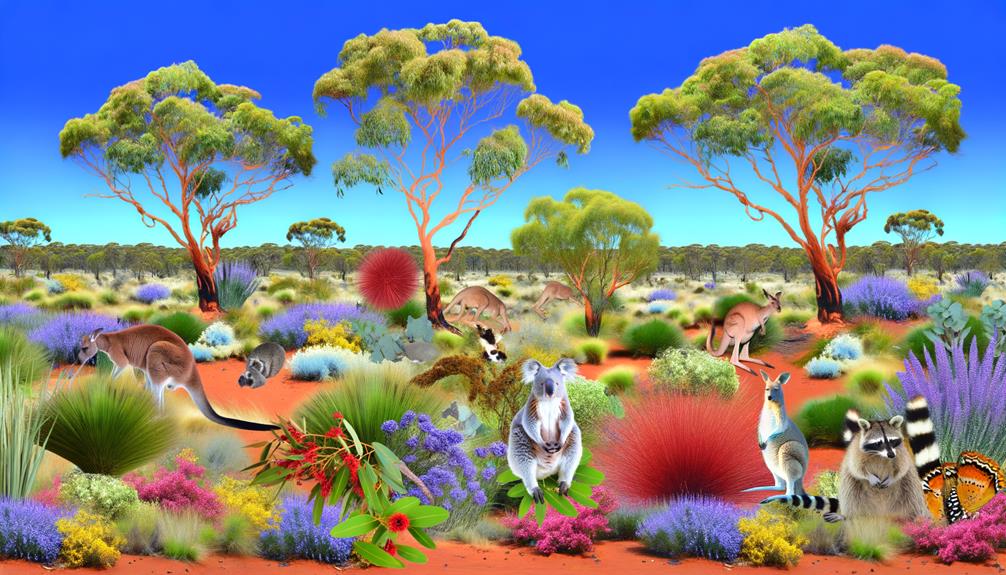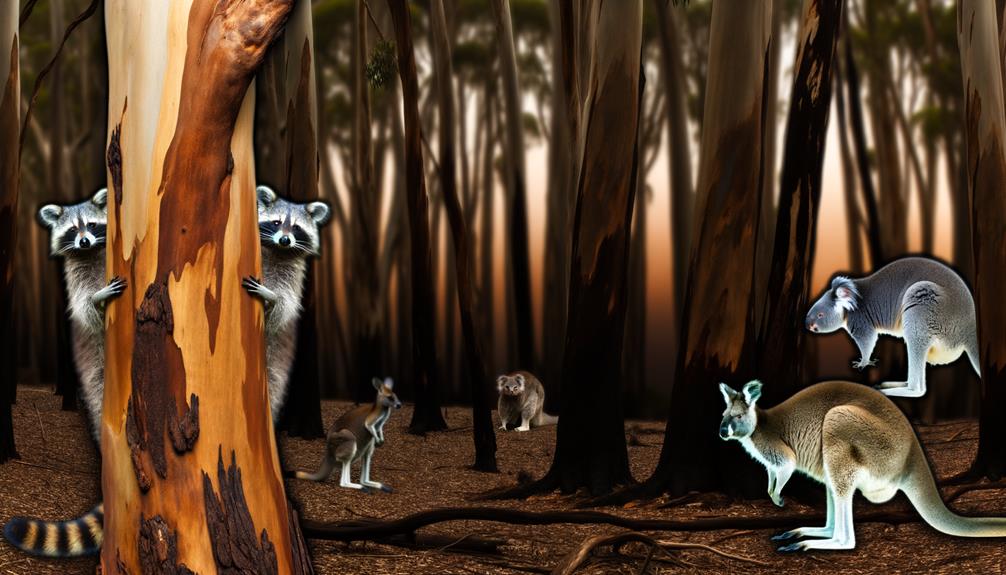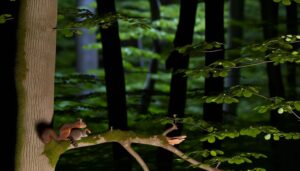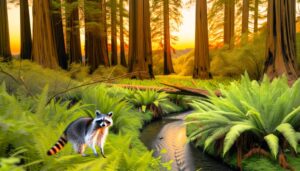Tracking Wildlife: Do Raccoons Live in Australia?
Raccoons are not native to Australia and there is no documented evidence of their presence in the wild. Their successful urban adaptation seen in other regions has not been observed in Australia.
Strict biosecurity protocols are in place to prevent their introduction due to the potential ecological threats they pose, including habitat disruption, competition with native species, and disease transmission. Australia's stringent import restrictions and quarantine measures are designed to protect native wildlife from such invasive species.
Effective biosecurity measures are critical to maintaining ecological balance. For a deeper understanding of potential ecological impacts and government regulations, continue exploring.

Key Takeaways
- Raccoons are not native to Australia and their presence is undocumented.
- Strict biosecurity protocols are in place to prevent raccoon introduction into Australia.
- Reported raccoon sightings in Australia are infrequent but trigger biosecurity alerts.
- Raccoons pose ecological threats, hence their introduction is heavily regulated.
- Raccoons in Australia are only found in controlled environments like zoos.
Origin of Raccoons

Raccoons (Procyon lotor) are native to North America, where they have evolved over millions of years, adapting to a wide range of habitats from forests to urban areas.
Their evolutionary lineage traces back to the Procyonid family, which includes other small to medium-sized mammals like coatis and kinkajous. Fossil evidence suggests that raccoons diverged from their relatives approximately 25 million years ago during the Oligocene epoch.
Their distinctive characteristics, such as dexterous front paws and a highly developed sense of touch, have enabled their survival and proliferation across diverse environments. These adaptations have facilitated their omnivorous diet and nocturnal behavior, making them highly versatile and resilient in different ecological niches.
Raccoon Habitat Preferences
Adaptable to a variety of environments, raccoons (Procyon lotor) exhibit a preference for habitats that provide abundant food sources and shelter. These mammals thrive in deciduous and mixed forests, where they can find ample food and denning sites in hollow trees. Wetlands offer a rich array of aquatic and terrestrial food sources, including crustaceans and small vertebrates.
Urban areas attract raccoons due to the availability of anthropogenic food sources, such as garbage and pet food, and numerous hiding spots in attics or under buildings. Their adaptability to diverse habitats is facilitated by their omnivorous diet, dexterous front paws, and nocturnal behavior, which reduce competition and predation.
Raccoon Adaptability

Raccoons exhibit remarkable adaptability, demonstrating an ability to thrive in diverse habitats ranging from dense forests to arid regions.
Their survival is further evidenced by their successful integration into urban environments, where they exploit various resources for sustenance.
Additionally, raccoons show significant resilience to varying climatic conditions, which enables them to maintain stable populations across different geographical areas.
Diverse Habitats Adaptation
Exhibiting remarkable ecological versatility, these mammals have successfully adapted to a wide range of habitats across the Australian landscape. Their adaptability is evidenced by their presence in diverse ecosystems, from dense forests to coastal regions. This flexibility is facilitated by their omnivorous diet, opportunistic feeding behavior, and ability to exploit various shelter options.
Forests:
Raccoons thrive in both temperate and tropical forests.
Wetlands:
They are adept at maneuvering and foraging in marshes and swamps.
Grasslands:
Open plains provide ample foraging opportunities.
Coastal Areas:
Their diet includes marine and terrestrial resources.
Suburban Zones:
They exploit human-modified environments for food and shelter.
This adaptability underscores the raccoon's resilience and capability to inhabit varied ecological niches.
Urban Environment Survival
In urban environments, their remarkable adaptability is further demonstrated by their ability to navigate complex human landscapes, utilizing resources such as refuse bins, gardens, and abandoned structures for sustenance and shelter.
Raccoons exhibit a high degree of behavioral flexibility, allowing them to exploit anthropogenic food sources and nesting sites efficiently. Their nocturnal habits enable them to avoid human activity while foraging, reducing the risk of encounters. These mammals possess dexterous forepaws, which facilitate the manipulation of objects and access to food containers. Additionally, raccoons display problem-solving skills that enhance their survival in urban settings.
Despite their adaptability, the presence of raccoons in Australia remains undocumented, suggesting that their successful urban strategies are yet to be observed in this specific locale.
Climatic Condition Resilience
Demonstrating remarkable physiological and behavioral adaptability, raccoons exhibit an impressive ability to withstand a diverse range of climatic conditions. This adaptability is essential for their survival in various habitats, from temperate forests to urban settings.
Their fur provides insulation against cold weather while their omnivorous diet allows them to exploit a wide array of food sources. Moreover, raccoons can enter a state of torpor during extreme conditions, reducing metabolic rates to conserve energy.
- Insulating fur: Offers protection against cold temperatures.
- Omnivorous diet: Enables utilization of diverse food resources.
- Torpor: Reduces metabolic demands during harsh conditions.
Versatile sheltering capabilities, including the ability to use various natural and man-made structures, further contribute to their survival. In addition, their behavioral adaptation, such as flexibility in activity patterns and foraging strategies, enhances their resilience.
These factors collectively enhance their ability to thrive in different environments.
Australia's Native Wildlife
Australia's native wildlife encompasses a diverse range of species uniquely adapted to the continent's varied ecosystems. Among the most notable are marsupials such as kangaroos, koalas, and wombats, which exhibit distinctive reproductive adaptations like pouch development for neonatal care.
Monotremes, including the platypus and echidna, represent primitive mammalian traits with egg-laying capabilities. Australia is also home to a plethora of reptiles, including numerous species of lizards, snakes, and the iconic saltwater crocodile.
Avian diversity is equally remarkable, with species such as the emu, kookaburra, and various parrots. Additionally, the continent's unique biodiversity includes a myriad of invertebrates, from diverse insect populations to the Great Barrier Reef's coral species, each playing an essential role in their respective habitats.
Invasive Species in Australia

The introduction of non-native species, including raccoons, has significant ecological consequences in Australia, disrupting local ecosystems and outcompeting indigenous fauna.
Thorough ecological impact analyses are essential for understanding these disruptions, which inform effective control measures to mitigate the threat to native wildlife.
Such measures are critical to preserving Australia's unique biodiversity and ensuring the stability of its natural habitats.
Ecological Impact Analysis
Evaluating the ecological impact of invasive raccoons in Australia requires a detailed examination of their effects on native species, ecosystems, and biodiversity. Raccoons, known for their adaptability and opportunistic feeding habits, can disrupt local habitats to a great extent.
Key areas of concern include:
- Predation: Raccoons may prey on small mammals, birds, and reptiles, leading to declines in native populations.
- Competition: They can outcompete native species for food and shelter.
- Disease Transmission: Raccoons are carriers of diseases such as rabies and leptospirosis, which can spread to native wildlife.
- Habitat Alteration: Their foraging behavior can damage vegetation and soil structure.
- Biodiversity Loss: These combined effects can lead to a reduction in overall biodiversity and ecosystem resilience.
This concise analysis highlights the necessity for in-depth ecological assessments.
Control Measures Implemented
In response to the ecological threats posed by invasive species like raccoons, various control measures have been implemented to mitigate their impact on Australia's native ecosystems. Key strategies include strict biosecurity protocols at borders to prevent raccoon introduction.
Surveillance programs are established to detect early incursions, enabling rapid response. Physical capture and removal, alongside humane euthanasia, are employed to manage populations. Public awareness campaigns educate citizens on identifying and reporting sightings.
Additionally, habitat modification techniques are used to make environments less welcoming to raccoons. Collaborative efforts between government agencies, conservation organizations, and local communities guarantee a multifaceted approach, enhancing the effectiveness of these measures and safeguarding Australia's biodiversity.
Native Wildlife Threats
Invasive species present significant threats to Australia's native wildlife, disrupting ecosystems and outcompeting indigenous species for essential resources. Australia's unique biodiversity is particularly vulnerable due to its long-term geographical isolation.
Introduced species can lead to:
- Predation: Many invasive species prey on native fauna, causing population declines.
- Competition: They compete for food, shelter, and other resources, often displacing native species.
- Disease Transmission: Invasive species can introduce new pathogens to which native species have no immunity.
- Habitat Alteration: Some invasive species modify habitats, making them unsuitable for native wildlife.
- Hybridization: Cross-breeding between invasive and native species can dilute genetic pools.
Understanding these impacts is essential for developing effective conservation strategies to protect Australia's unique ecosystems.
Raccoons in Captivity
Due to Australia's strict biosecurity laws, raccoons can only be found in captivity under stringent regulatory oversight to prevent any potential ecological impact. These animals are housed primarily in zoological institutions and wildlife sanctuaries, where their care is carefully managed.
Strict protocols are in place to ensure that raccoons do not escape into the wild, given their potential to disrupt local ecosystems and outcompete native species. Facilities holding raccoons must comply with detailed guidelines, including quarantine measures, containment standards, and regular health assessments.
Such thorough controls are crucial, as raccoons are not native to Australia and pose significant risks as an invasive species. This controlled environment allows for educational and research opportunities while protecting Australia's unique biodiversity.
Sightings and Reports

While raccoons in Australia are commonly found in controlled environments, occasional sightings and unverified reports of raccoons in the wild have sparked significant concern among biosecurity experts. These reports, though infrequent, require thorough investigation to verify authenticity and assess potential risks.
Documented incidents include:
- 2008: A reported sighting in a suburban Melbourne backyard.
- 2012: Unconfirmed raccoon tracks near a wildlife reserve in New South Wales.
- 2017: Alleged raccoon sighting by hikers in Queensland.
- 2020: Possible raccoon sighting reported by a farmer in Western Australia.
- 2022: Social media posts suggesting raccoon presence in rural Victoria.
These instances, whether verified or speculative, necessitate ongoing monitoring to prevent potential ecological disruptions and safeguard biosecurity integrity.
Environmental Impact
Evaluating the environmental impact of raccoons in Australia requires a thorough understanding of their potential effects on local ecosystems and native species. As omnivores, raccoons could disrupt food webs by preying on small mammals, birds, and invertebrates. They are known to scavenge extensively, potentially outcompeting native species for resources.
Additionally, raccoons may facilitate the spread of diseases such as rabies and leptospirosis, posing a threat to native wildlife and human populations. Their foraging behavior can also lead to habitat degradation, particularly in sensitive areas such as wetlands. Given these factors, the presence of raccoons in Australia could have significant ecological consequences, necessitating careful consideration and monitoring to protect biodiversity and ecosystem integrity.
Government Regulations

Evaluating the potential ecological consequences of raccoons in Australia necessitates examining the government regulations in place to manage and mitigate their impact. Australia's biosecurity measures are stringent, aiming to prevent the introduction of invasive species that could threaten native biodiversity.
Key regulations include:
- Import Restrictions: Strict controls on the importation of non-native species, including raccoons.
- Quarantine Procedures: Thorough quarantine protocols to detect and prevent the entry of raccoons at border points.
- Wildlife Monitoring: Ongoing surveillance and monitoring programs to detect early incursions of non-native species.
- Eradication Policies: Rapid response strategies for the eradication of invasive species upon detection.
- Public Awareness Campaigns: Educational initiatives to inform the public about the risks and regulations concerning non-native species.
These measures collectively aim to safeguard Australia's unique ecosystems.
Potential Risks
Introduction of raccoons into Australia poses significant ecological threats due to their potential to disrupt native wildlife, spread diseases, and compete with indigenous species for resources.
Raccoons are omnivorous, opportunistic feeders that could outcompete native fauna, such as possums and bandicoots, for food sources. Their foraging behavior can disturb nesting sites of ground-dwelling birds and small mammals.
Additionally, raccoons are known carriers of various zoonotic diseases, including rabies and leptospirosis, which could pose health risks to both humans and native animals. Their adaptability to diverse environments further exacerbates these threats, potentially leading to significant biodiversity loss.
Understanding the potential ecological risks is essential for informed decision-making regarding wildlife management and biosecurity measures in Australia.
Conservation Efforts

Implementing extensive conservation efforts is essential to mitigating the ecological threats posed by the potential introduction of raccoons into Australia. Raccoons, being non-native species, could disrupt local ecosystems, outcompete indigenous fauna, and spread diseases.
To prevent these adverse impacts, thorough strategies must be enacted. These strategies encompass:
- Surveillance: Continuous monitoring at ports and borders to prevent illegal importation.
- Public Awareness: Educating the public on the risks associated with non-native species.
- Research: Conducting scientific studies on potential ecological impacts and effective mitigation measures.
- Policy Development: Formulating stringent biosecurity laws and regulations.
- Rapid Response: Establishing emergency protocols for quick action in case of raccoon sightings.
These collective efforts are essential in preserving Australia's unique biodiversity and ecological balance.
Conclusion
To sum up, raccoons, native to North America, are not native to Australia. Their ability to thrive in different habitats raises concerns about potential ecological impacts if introduced.
Australia's distinct native wildlife and strict biosecurity measures aim to prevent the introduction of invasive species like raccoons. Government regulations and conservation efforts are essential to reduce risks and safeguard biodiversity.
The hypothetical introduction of raccoons could disturb ecological harmony much like a bull in a china shop, highlighting the significance of stringent environmental policies.






